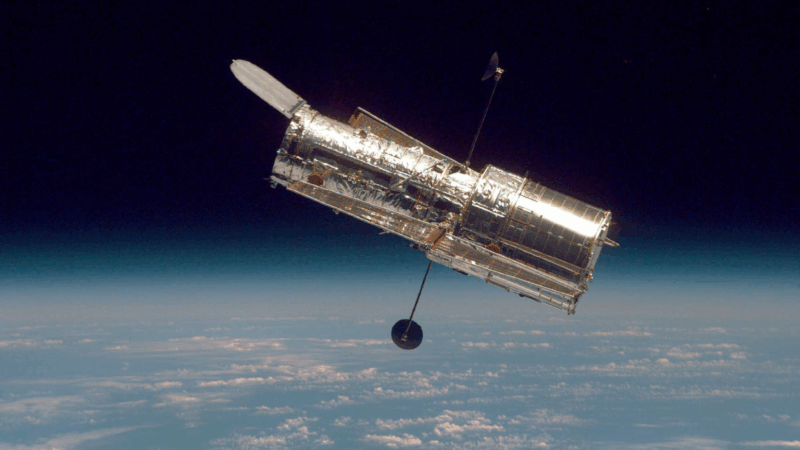Trump unveils ambitious and expensive plans for ‘Golden Dome’ missile defense
President Trump on Tuesday unveiled an ambitious plan to shield America from missile attack by building what he describes as a “Golden Dome.”
“Once fully constructed the Golden Dome will be capable of intercepting missiles even if they are launched from other sides of the world and even if they are launched from space,” Trump told reporters in the Oval Office.
Trump’s budget and timeline for the project are ambitious. He told reporters he hoped to have it done “before the end of my term.” The system would cost around $175 billion, the president said, with $25 billion to start construction in next year’s budget.
A key part of the Trump plan is to place both missile-sensing and missile-destroying satellites into orbit above the Earth. The constellation would likely involve thousands of small satellites capable of attacking a missile in the moments after it launches from its submarine or silo.
Such a vast network of satellites would have been unthinkable just a few years ago, but it now seems at least theoretically within reach. Elon Musk’s company SpaceX has been using low-cost rockets to launch a constellation of internet-transmitting satellites known as Starlink. SpaceX says the Starlink system currently has around 7,000 satellites in orbit, a scale that is comparable to most estimates of what a limited space-based missile defense capability would require.
“The overall Golden Dome effort is long overdue,” says Tom Karako, director of the missile defense project at the Center for Strategic and International Studies. Karako concedes that space-based interception of incoming missiles is a “wicked hard problem,” but he says the reality is that the next large war will likely be fought partially above Earth’s atmosphere. Given that reality, he thinks Golden Dome’s capabilities will provide the U.S. with a robust defense that could also be used for anti-satellite warfare if needed.
“There’s a need to contend with a whole lot of things that are in space and going through space,” he says.
Space-based missile defense has been a dream of politicians for decades. In 1983, Ronald Reagan announced plans for a system to intercept missiles from the then-Soviet Union.
“I know this is a formidable task, one that may not be accomplished before the end of this century,” Reagan said at the time. “It will take years, probably decades of effort on many fronts.”
In the end, the Soviet Union collapsed before anything approaching Reagan’s vision could be realized, but missile defenses have progressed. U.S. Patriot missiles have worked for decades to intercept shorter-range missiles, and the U.S. now has several systems capable of intercepting medium- and intermediate-range ballistic missiles. It also has a small number of interceptors capable of hitting ICBMs during the middle of their flight. That capability is aimed squarely at nuclear upstart North Korea.
Other countries, namely Israel and Ukraine, have used missile defenses to protect themselves from attack in recent years.

But intercepting Intercontinental Ballistic Missiles in large numbers remains a far more difficult problem. ICBMs launch from deep inside enemy territory and scream back to Earth at hypersonic speeds, making them nearly impossible to hit at the end of their flight. They can also deploy decoys that can fool interceptors. The best time to hit them is as they’re just launching from their silos, but doing so requires an extremely quick response by space-based interceptors. Thousands of interceptors must be launched in order to ensure that one is passing above a missile when it launches.
Whether the technology has, in fact, arrived is far from clear.
An orbital system would be complex, costly and ultimately vulnerable to counterattack, warns Laura Grego, a physicist at the Union of Concerned Scientists, a group skeptical of missile defense development. Grego says that a network like Golden Dome could be defeated by clustering launches to overwhelm the system, or by attacking the satellites themselves. The U.S. has recently accused Russia of studying how to place nuclear warheads in orbit. Such a warhead could knock out large sections of any Golden Dome system in space.
And the threats facing the U.S. are more diverse than ever. A recent report from the Defense Intelligence Agency showed that Golden Dome would also have to contend with new and emerging threats like cruise missiles, hypersonic missiles that can skim the edge of space and weapons known as Fractional Orbital Bombardment Systems, which can launch, glide through part of an orbit around the Earth and then attack from any direction.
The overall price of Golden Dome is far from certain. While the president says it could be done for $175 billion over three years, a recent estimate from the Congressional Budget Office put the cost at between $161-$542 billion over two decades. Separately, Sen. Tim Sheehy, R-Mont., who is heading a “Golden Dome caucus,” recently told a crowd that, “It will likely cost in the trillions if and when Golden Dome is completed,” according to Space News.
Given the potential high costs, Grego hopes that Congress will take a careful look before giving the Trump administration money to pursue the system. The road to missile defense “is littered with programs that were started and abandoned after some number of years,” Grego says. “I would say ask the hard questions at the beginning, before you go down this road.”
Tributes, not politics, play center stage as Trump hosts the Kennedy Center Honors
President Trump said he was closely involved with picking the honorees, and on Sunday he became the first president to host the Kennedy Center awards ceremony.
Thailand launches airstrikes along border with Cambodia as tensions reignite
Both sides accused the other of breaking a ceasefire that halted fighting earlier this year. Longstanding border disputes erupted into five days of combat in July that killed dozens.
Rafael Ithier, a legend of salsa music, dies at 99
The pianist, composer and arranger spent more than six decades turning El Gran Combo into one of the premier salsa institutions of Latin America and beyond.
Light from satellites will ruin majority of some space telescope images, study says
Astronomers have long been concerned about reflections from satellites showing up in images taken by telescopes and other scientific instruments.
Defense Department is reviewing boat strike video for possible release, Hegseth says
In a speech on Saturday, Defense Secretary Pete Hegseth defended the strikes, saying: "President Trump can and will take decisive military action as he sees fit to defend our nation's interests."
Bama, Miami in, Notre Dame out and Indiana No. 1 in College Football Playoff rankings
Nobody paying attention for the past 24 months would be surprised to see Indiana – yes, Indiana – leading the way into this year's College Football Playoff.









